Revisiting Epigraphic Evidence of the Oldest Synagogue in Morocco in Volubilis
Abstract
1. Introduction
2. Epigraphic Evidence
2.1. Inscription One
| מטרונא | Matrona |
| בת רבי | the daughter of Rabbi |
| יהודה נח | Yehuda, [may she] rest [in peace] |
2.2. Inscription Two
| ὧδε κοιμᾶτε | Rest in peace here, |
| Καικιλιανὸς ὁ | Caecilianus |
| προτοπολίτης | a Protopolites, |
| πατὴρ τες συνα | the head of the cong- |
| γογὴς τῶν Ἰου | regation of the Je- |
| δέων ἠτῶν με` | ws, 45 years |
| μενας η` ἑμέρας γ` | 8 months and 3 days |
2.3. Inscription Three
| DM S | For the ghost gods |
| Ant(onii) Sabba | Antonii Sabba- |
| tr[a]i; uix(it) annis (tribus), menses (quinque) et die | trai. He lived (three) years (five) months |
| bus (quattuor); pater pi(i)ssimus fe | and (four) days; by loving father |
| c(i)t. | made. |
2.4. Additional Findings
| Μαρεῖνος | Marinus23 |
| Πτολεμαῖ | Ptolemaeus |
| ος Ἰου | from Ju- |
| δέος | Dea |
3. Archeological Evidence
4. Conclusions
Author Contributions
Funding
Acknowledgments
Conflicts of Interest
References
- Albrecht, Stefan. 2015. Who was Protopolit Zoilus from Cherson? Materials in Archaeology and History of Ancient and Medieval Crimea 7: 197–203. [Google Scholar]
- Berger, Philippe. 1892. Rapport de M. Berger sur une Inscription Punique Trouvée a Lixus et sur une Inscription Juive Ancienne de Volubilis. In Bulletin Archéologique du Comité des Travaux Historiques at Scientifiques. Edited by E. Leroux. Paris: Ministère de l’Instruction Publique et des Beaux-Arts, pp. 62–66. [Google Scholar]
- Besnier, Maurice. 1904. Recueil des Inscriptions Antiques du Maroc. Paris: Archives Marocains I, pp. 366–415. [Google Scholar]
- Brahmi, Néjat. 2014. Territorium, camps militaires et espace d’influence: les territoires du religieux à Volubilis Centres de pouvoir et organisation de l’espace. Paper presented at the 2009 Xe Colloque International sur L’histoire et L’archéologie de l’Afrique du Nord, Caen, France, May 25–28; pp. 543–56. [Google Scholar]
- Brooten, Bernadette J. 1982. Women Leaders in Ancient Synagogue. Inscriptional Evidence and Background Issues. Ser. Brown Judaic Studies. Chico: Scholars Press, vol. 36. [Google Scholar]
- CIJ. 1975. Corpus Inscriptionum Judaicarum = Corpus of Jewish Inscriptions: Jewish Inscriptions from the Third Century B.C. to the Seventh Century A.D. Par Jean-Baptiste Frey prolegomenon by Baruch Lifshitz. New York: Ktav Pub House, vol. 1. [Google Scholar]
- CIJP. 2010. Corpus Inscriptionum Iudaeae/Palestinae: A Multi-Lingual Corpus of the Inscriptions from Alexander to Muhammad. Edited by Hanna M. Cotton. Berlin: Walter de Gruyter. [Google Scholar]
- CIRB. 1965. Corpus Inscriptionum Regni Bosporani. Edited by V. V. Struve, M. N. Tikhomirov, V. F. Gaidukevich, A. I. Dovatur, D. P. Kallistov and T. N. Knipovich. Moskva: Moscow-Leningrad. [Google Scholar]
- Cohen, Shaya J. D. 1981. Epigraphical Rabbis. The Jewish Quarterly Review 72: 1–17. [Google Scholar] [CrossRef]
- Fraser, Peter M., and Elaine Matthews. 1987. A Lexicon of Greek Personal Names. Oxford: Clarendon Press. [Google Scholar]
- Frézouls, Edmond. 1956. Inscriptions nouvelles de Volubilis (II). Mélanges de l’école française de Rome 68: 95–125. [Google Scholar] [CrossRef]
- Frézouls, Edmond. 1971. Une synagogue juive attestée à Volubilis. In Acta of the 5th International Congress of Greek and Latin Epigraphy. Oxford: Blackwell, pp. 287–92. [Google Scholar]
- Goodenough, Erwin. R. 1953. Jewish Symbols in the Greco-Roman Period. New York: Pantheon Books. [Google Scholar]
- Hasan-Rokem, Galit. 2014. Leviticus Rabbah 16, 1—Odysseus and the Sirens in the Beit Leontis Mosaic from Beit She’an. In Talmuda De-Eretz Israel: Archaeology and the Rabbis in Late Antique Palestine. Edited by Steven Fine and Aaron Koller. Berlin: De Gruyter, pp. 159–89. [Google Scholar]
- Hengel, M. 1975. Proseuche und Synagoge. In The Synagogue: Studies in Origins, Archeology and Architecture. New York: Ktav Pub & Distributors Inc, pp. 27–54. [Google Scholar]
- Hirschberg, H. Z. 1974. A History of the Jews in North Africa. Leiden: Brill. [Google Scholar]
- IJO. 2004. Inscriptiones Judaicae Orientis. Edited by David Noy, Alexander Panayotov and Hanswulf Bloedhorn. Tübingen: Mohr Siebeck. [Google Scholar]
- Ilan, Tal. 2008. Lexicon of Jewish Names in Late Antiquity. Tubingen: Mohr Siebeck. [Google Scholar]
- JIWE. 2005. Jewish Inscriptions of Western Europe. Edited by David Noy. Cambridge: Cambridge University Press. [Google Scholar]
- Kiperwasser, Reuven. 2019. Going West. Migrating Babylonians and the Question of identity. In A Question of Identity: Social, Political, and Historical Aspects of Identity Dynamics in Jewish and Other Contexts. Berlin: Walter de Gruyter GmbH & Co, pp. 111–30. [Google Scholar]
- Kravtsov, Sergey R. 2019. Synagogue Architecture of Latvia between Archeology and Eschatology. Arts 8: 99. [Google Scholar] [CrossRef]
- Le Bohec, Yann. 1981. Inscriptions juives et judaïsantes de l’Afrique romaine. Antiquités africaines 17: 165–207. [Google Scholar] [CrossRef]
- Leon, Harry J. 1960. The Jews of Ancient Rome. Philadelphia: The Jewish Publication Society of America. [Google Scholar]
- Levine, Lee I. 2000. The Ancient Synagogue: The First Thousand Years. New Haven: Yale University Press. [Google Scholar]
- Levinskaya, Irina A. 1992. Review: Joyce Reynolds, Robert Tannenbaum. Jews and Godfearers at Aphrodisias. Greek Inscriptions with Commentary. Cambridge, 1987. Vestnik Drevney Istorii 2: 196–201. [Google Scholar]
- LSJ. 1996. A Greek-English Lexicon, 9th ed. Edited by G. Liddell and R. Scott. Oxford: Clarendon Press. [Google Scholar]
- Marion, Jean. 1960. La Population de Volubilis à L’époque Romaine. Rabat: Ministère des Affaires Culturelle. [Google Scholar]
- Nosonovsky, Michael. 2002. M. Hocoнoвcкий, Eвpeйcкий памятник VIII-IX вв. из Тамани (A Jewish monument of the 8th–9th centuries from Taman). Zametki po evreyskoy istorii 4. Available online: http://berkovich-zametki.com/Nomer4/MN13.htm (accessed on 1 September 2019). (In Russian).
- Nosonovsky, Michael. 2017. Connecting Sacred and Mundane: From Bilingualism to Hermeneutics in Hebrew Epitaphs. Studia Humana 6: 96–106. [Google Scholar] [CrossRef]
- Noy, David. 1993. Jewish Inscriptions of Western Europe Volume 1. Italy (Excluding the City of Rome), Spain and Gaul. Cambridge: Cambridge University Press. [Google Scholar]
- Olman, Arye. 2015. למה קראו לשפת העם לשון חכמים (Why “the language of the Hebrew men” is called “Leshon Hachamim”?). הד האולפן החדש 103: 130–37. [Google Scholar]
- Panetier, Jean-Luc. 2002. Volubilis, une cité du Maroc antique. Paris: Maisonneuve et Larose. [Google Scholar]
- Ponsich, M. 1961. Les lampes en terre cuite de la Mauritanie Tingitane. Rabat: Centre National de la Recherche Scientifique. [Google Scholar]
- Rahmani, Levi Y. 1994. A Catalogue of Jewish Ossuaries in the Collections of the State of Israel. Edited by Ayala Sussmann. Israel Antiquities Authority, Israel Academy of Sciences and Humanities: Available online: https://library.brown.edu/cds/projects/iip/viewinscr/khzi0001/ (accessed on 1 September 2019).
- Risse, Martina. 2001. Volubilis. Eine Rőmische Stadt in Marokko von der Frũhzeit bis die Islamische Periode. Mainz am Rhein: Verlag Philipp von Zabren. [Google Scholar]
- Rodov, Ilya. 2013. The Torah Ark in Renaissance Poland: A Jewish Revival of Classical Antiquity. Leiden: Brill. [Google Scholar]
- Anders Runesson, Donald D. Binder, and Birger Olsson. 2010. The Ancient Synagogue from its Origins to 200 CE. Leiden and Boston: Brill. [Google Scholar]
- Saar, Ortal-Paz S. 2016. Review of Antonio E. Felle and Anita Rocco (eds.), Off the Beaten Track: Epigraphy at the Borders. Bryn Mawr Classical Review 12: 30. Available online: http://bmcr.brynmawr.edu/2016/2016-12-30.html (accessed on 1 September 2019).
- Saar, Ortal-Paz. 2017. Jewish Love Magic: From Late Antiquity to the Middle Ages. Leiden: Brill. [Google Scholar]
- Schrüer, Emil. 1973. The History of the Jewish People in the Age of Jesus Christ. London: Bloomsbury, vol. III. [Google Scholar]
- Simonsohn, Shlomo. 1974. The Hebrew revival among early medieval European Jews. In Salo Wittmayer Baron Jubilee Volume. Ann Arbor: American Academy for Jewish, pp. 831–58. [Google Scholar]
- Spagnoli, Federica. 2006. Altars and Cult Installations of Punic Tradition in North Africa. Paper presented at Symposium on Mediterranean Archaeology: Proceedings of the Eighth Annual Meeting of Postgraduate Researchers, Dublin, Ireland, February 20–22; Edited by Joan Day, C. Greenlaw, H. Hall, A. Kelly, L. Matassa, K. McAleese, E. Saunders and D. Stritch. Oxford: Tempus Reparatsm, pp. 173–80. [Google Scholar]
- Stern, Karen B. 2008. Inscribing Devotion and Death Archaeological Evidence for Jewish Populations of North Africa. Boston: Brill. [Google Scholar]
- Thouvenot, Raymond. 1969. Les origines chrétiennes en Maurétanie Tingitane. Revue des Études Anciennes 71: 354–78. [Google Scholar] [CrossRef]
- van der Horst, Pieter Willem. 1991. Ancient Jewish Epitaphs. Kampen: Kok Pharos Publishing House. [Google Scholar]
- Ward Perkins, John B. 1952. Excavations in the Severan Basilica at Lepcis Magna, 1951. Papers of the British School at Rome 20: 111–12. [Google Scholar] [CrossRef]
- Weiss, Zeev. 2014. Was It a Synagogue? Preliminary Thoughts on the New Finds from Limyra. Journal of Ancient Judaism 5: 153–61. [Google Scholar] [CrossRef]
| 1 | Cohen (1981, pp. 1–17) noted that Jewish inscriptions from North Africa are less known than from other region. There is no comprehensive corpus of such inscriptions, except for the article in French by Le Bohec (1981), which provides a list of 81 inscriptions without their translations and without photographs. Hopefully, recent efforts in “Digital Humanities” will eventually include also cataloging ancient Jewish inscription; efforts in this direction are made, in particular, by Saar (2016, 2017). |
| 2 | Karen Stern states: “North African Jewish texts provide no evidence of the languages Jews spoke, although the preponderant combination of Latinate onomastic and linguistic tendencies indicates that the majority of western African Jews were Latin dialect speakers. In all cases, commemorative language serves as a flexible implement to mark the identities of North African Jews after their deaths” (Stern 2008, p. 191). |
| 3 | About the sacral function of Hebrew epitaph see (Nosonovsky 2017). |
| 4 | For example, the reinterpretation of the story of Odysseus and Sirens in a mosaic of the Beit-Leontis synagogue in Beit-She’an (Hasan-Rokem 2014, pp. 159–89). Kiperwasser (2019) studied rabbinical sources on the migration of Babylonian Jews to the west and notes that “the relationship between the Diaspora Jew and the Land of Israel is expressed in the conflicted self-perception” (Kiperwasser 2019, p. 126). However, much less is known about Jewish migration to such extreme western region as Mauretania Tingitana. |
| 5 | See (Cohen 1981, pp. 1–17), also note 17. |
| 6 | Due to extremely poor knowledge of Hebrew, which was considered לשון חכמים (“the language of the sages”), Jewish epitaphs from first centuries CE from Italy rarely used Hebrew besides single words (Olman 2015, p. 136). Moreover, numerous mistakes were typical for Hebrew epitaphs from the first centuries from Italy, including ינוח for the feminine (Noy 1993, Nos 164, 167), משכהבו instead of משכבהו (Noy 1993, Nos 120, pp. 138, 143) and even an inscription written from left to right (Noy 1993, pp. 310–11, 334–39; 232). Simonsohn (1974, p. 847) asserts that “the knowledge of Hebrew among European Jewry of that period [until the 5th century] was apparently very restricted and expressed itself in a few standard words in the tombs’ inscriptions”. |
| 7 | Stern (2008, pp. 140–41). The name Matrona was spread in 3th–4th CE among Jewish population of Egypt, Rome, Gaul, and Asia (Ilan 2008, vol. 3, p. 599). Final aleph (and not hey) shows Greek long e (Ματρώνη, lat. Matrona) (Ilan 2008, vol. 1, pp. 25–26). Note also, that it was very common in various parts of the Jewish diaspora that female names were borrowed from local non-Jewish languages. |
| 8 | Compare with the epitaph בזה הקבר תנח מרים (‘In this grave Miriam will rest’) from Phanagoria in South Russia (Nosonovsky 2002); standard formula נפש נח, e.g., in Faustina’s epitaph in Venosa (Simonsohn 1974, p. 849). |
| 9 | |
| 10 | CIJ passim, various spelling. |
| 11 | |
| 12 | Such as Kaikilios, Kaikilis, or female Kaikiliane, Kaikilia of the same period, and very few in other periods. For Greek variants see (Fraser and Matthews 1987). The Latin name Caecilianus was also very popular during the same period in the region of North Africa, see (Frézouls 1956, p. 98; Ilan 2008, vol. 3, p. 475). For Latin inscriptions from Volubilis see (Besnier 1904, Nos. 37–39, 57, 61–63). |
| 13 | CIIP 3847. |
| 14 | See, for example, (CIJ 1975, pp. 319, 494; IJO 2004, Mac 1) etc. |
| 15 | |
| 16 | IJO BS5 = (CIRB 1965). |
| 17 | IJO Mac 1. Cf. meter tes synagoges (“mother of synagogue” in (Brooten 1982, p. 57ff)), also the common term archisynagogos or archon tes synagoges discussed in (Brooten 1982, pp. 15–30). The meaning of the word “synagogue” as a house of worship and as a congregation is a complicated issue. Thus, in the Septuagint the word ﬠדה (congregation) was translated as “synagogue,” while Josephus uses the word “synagogue” for a building in his Bellum Judaicum 2, chapters 285–292. For a discussion on the Greek and Jewish terms in Greek literary sources and epigraphy see (Hengel 1975, pp. 27–54). The collection of literary and epigraphic resources is found in (Runesson et al. 2010). Note that the Hebrew term for the synagogue, כנסת בית (bet-keneset), literary means “house of congregation”. |
| 18 | |
| 19 | See (van der Horst 1991, p. 68), with literature. |
| 20 | For parallels see (Ilan 2008, vol. 3, pp. 186–92). |
| 21 | CIL 21900, 21901. For different variants of the Greek tranliteration (Σάλμων, Σελέμων, Σαλάμων, Σολομών, etc.), see: (Ilan 2008, vol. 3, pp. 161, 191–92). |
| 22 | Brahmi (2014, p. 549). He mentions the epitaph of “DMS/Anniae bene m(erentis)/Vixit/ann(is)”; however, it is unclear why this epitaph is Jewish, since the name Anna could be both Jewish or Christian. |
| 23 | Ilan (2008, vol. 3, pp. 521–22), lists examples from Rome, Egypt, and Carthago. |
| 24 | Hirschberg notes in his chapter that having Greek names and using the Greek language was common among the North African Jews of the period: “Most probably, that man obtained Roman citizenship under the law of Antoninus (Caracalla) in 212 and, like many others, added to his Greek name the personal name of that emperor: Marcus Aurelius (Antoninus). His Hellenistic name and the Greek scripts suggest that he or his forebears came from the eastern region, perhaps from Cyrenaica, or even from Egypt. The name Salimos, found in Volubilis in Greek script, is general Semitic; it was used also by the Arabs, and occurs already among the Jews of Elephantine” (Hirschberg 1974, p. 68). Stern states that “The percentage of Jewish inscriptions in the Greek language and Greek scripts from Africa Proconsularis, Mauretanian Caesaria, Mauretanian Tingitania, and Mauretanian Sitifis exceeds the general percentage of Greek to Latin inscriptions within those areas” (Stern 2008, p. 191). |
| 25 | Rodov (2013) states that the relationship of the Jewish culture in Renaissance Poland with the earlier adaptations of the Christian revival of classical antiquity by Italian Jews made a significant impact upon the formation of East European synagogue art. The remains of ancient synagogues became a new source of inspiration for synagogue architecture during the second half of the nineteenth century and the early part of the twentieth century in both Europe and America (Kravtsov 2019). |
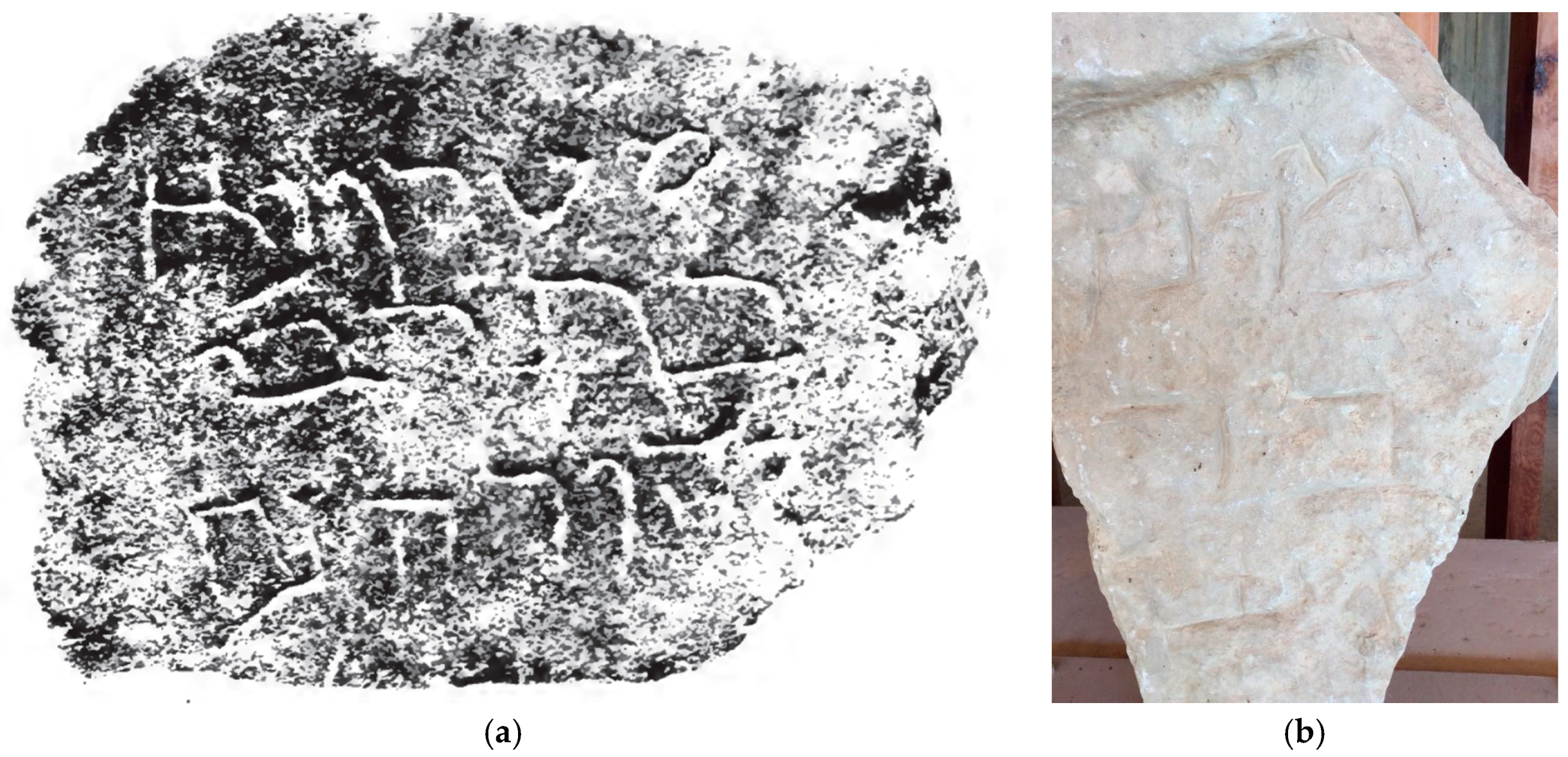
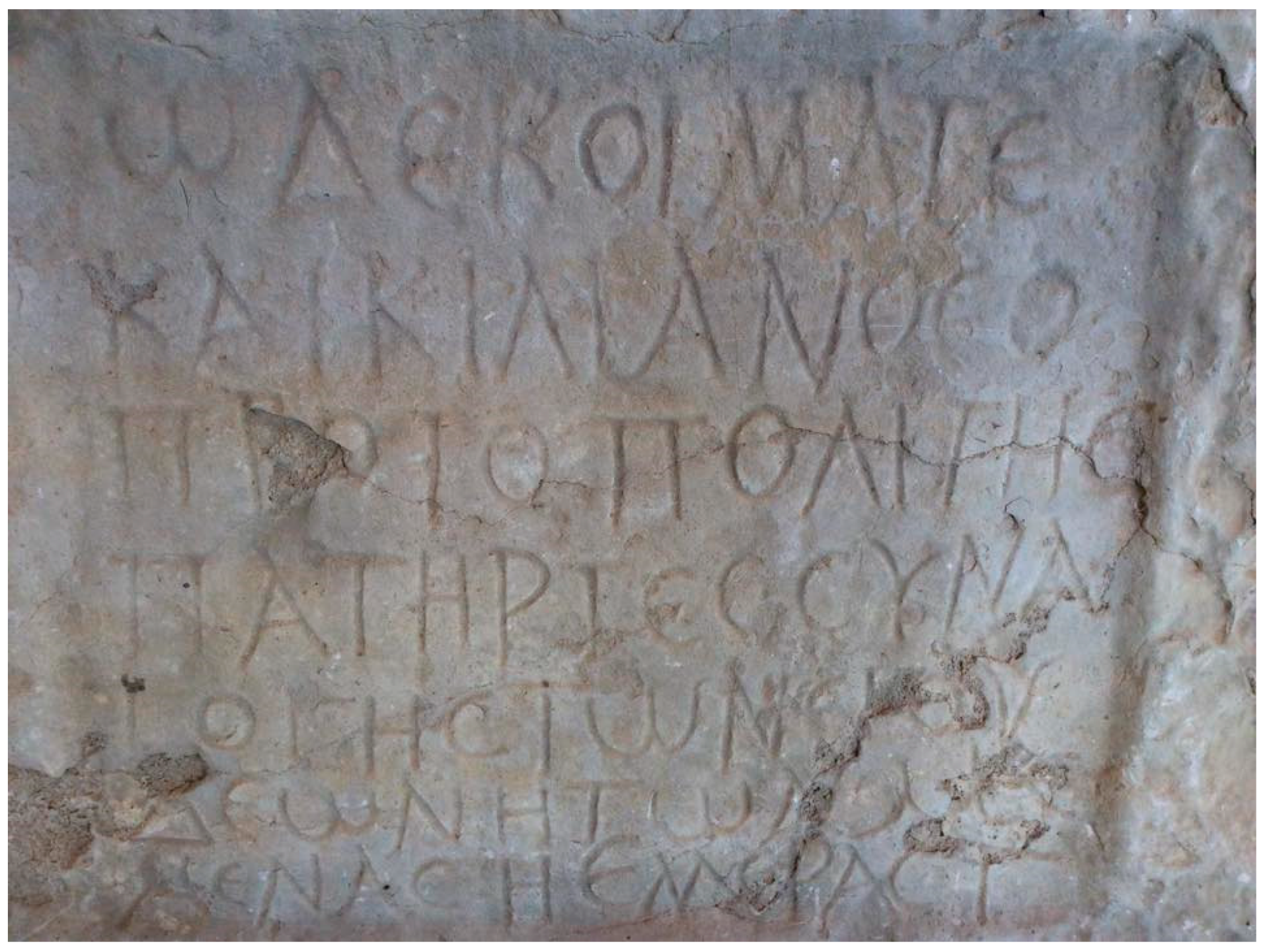
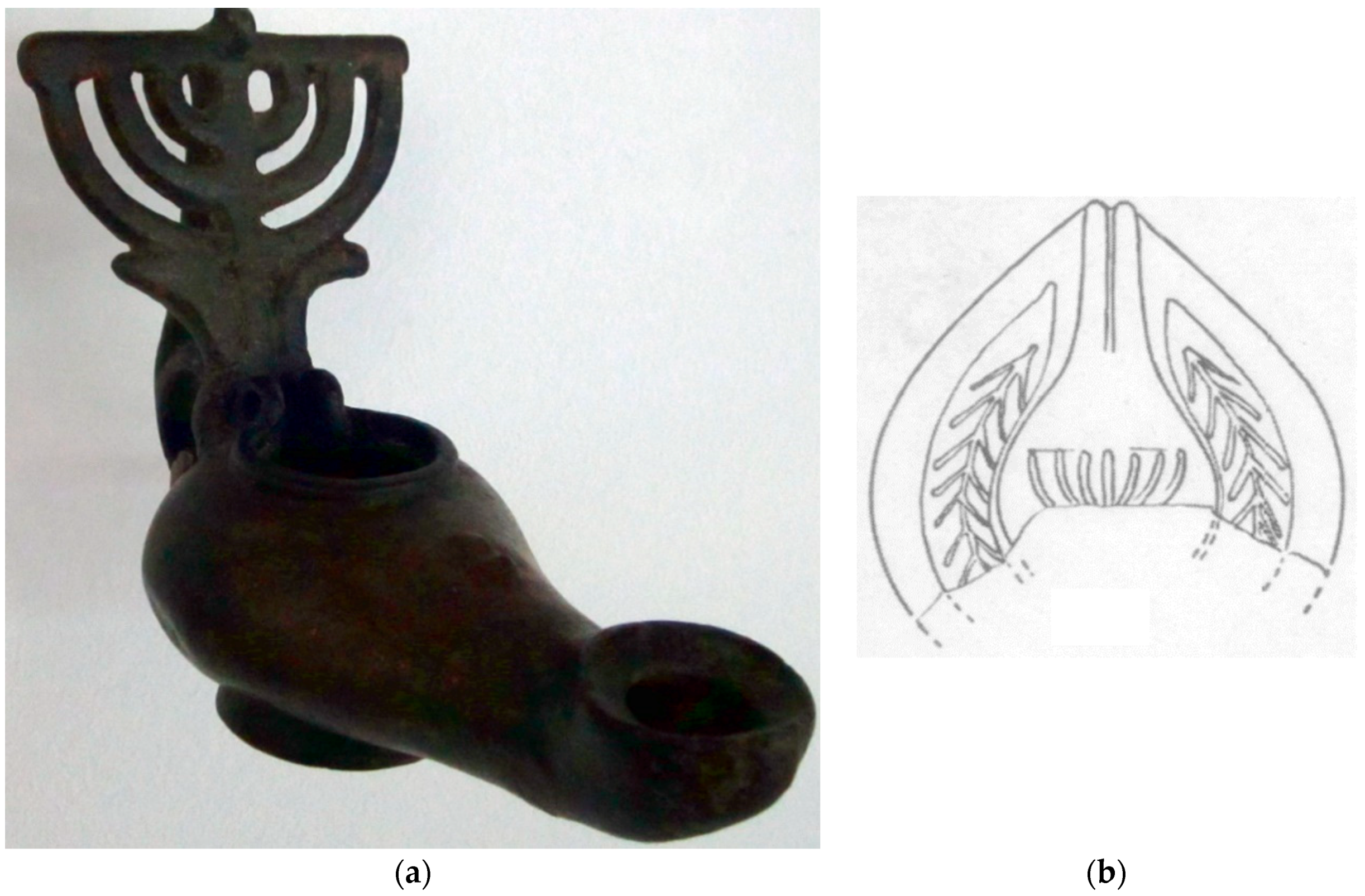
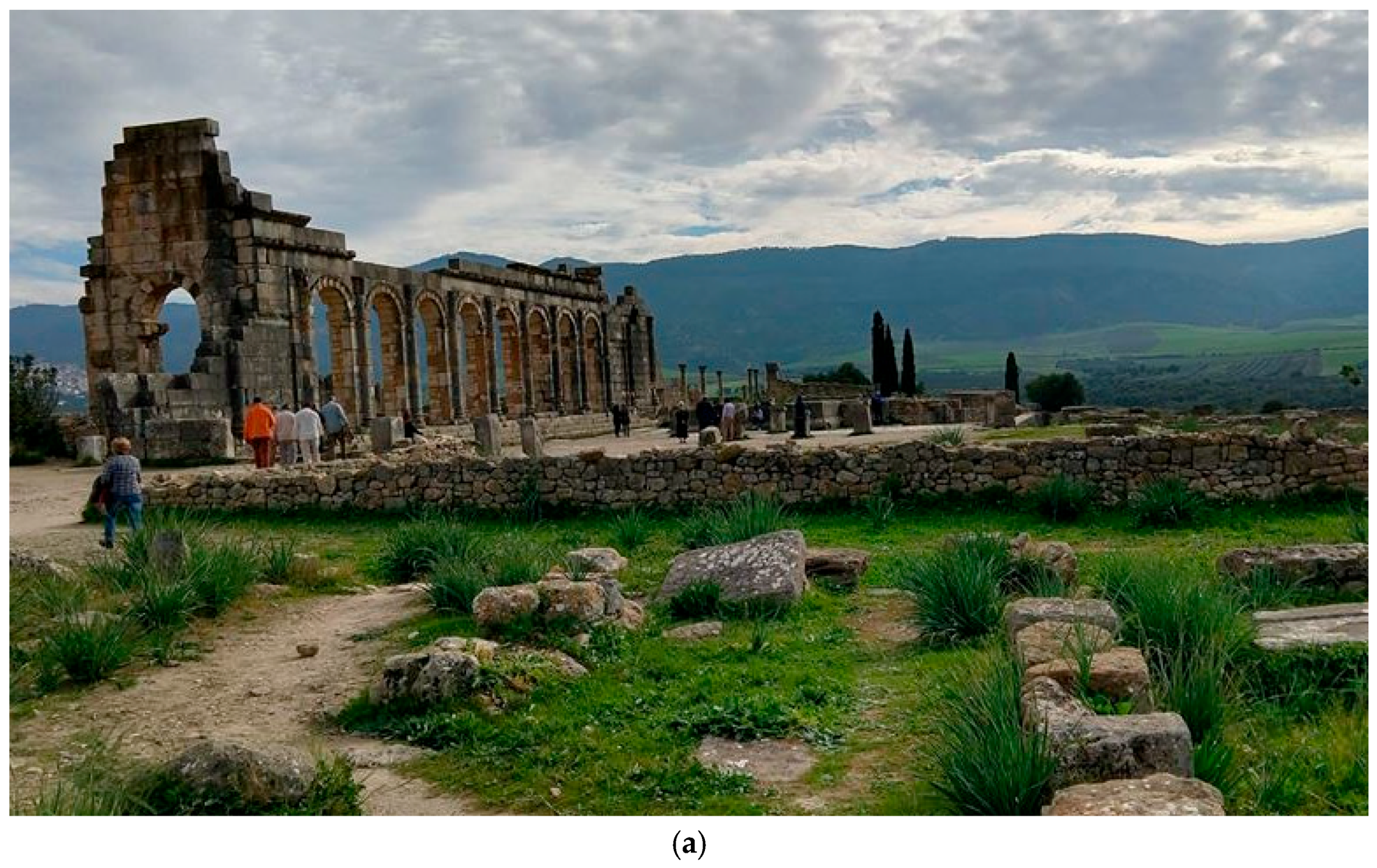
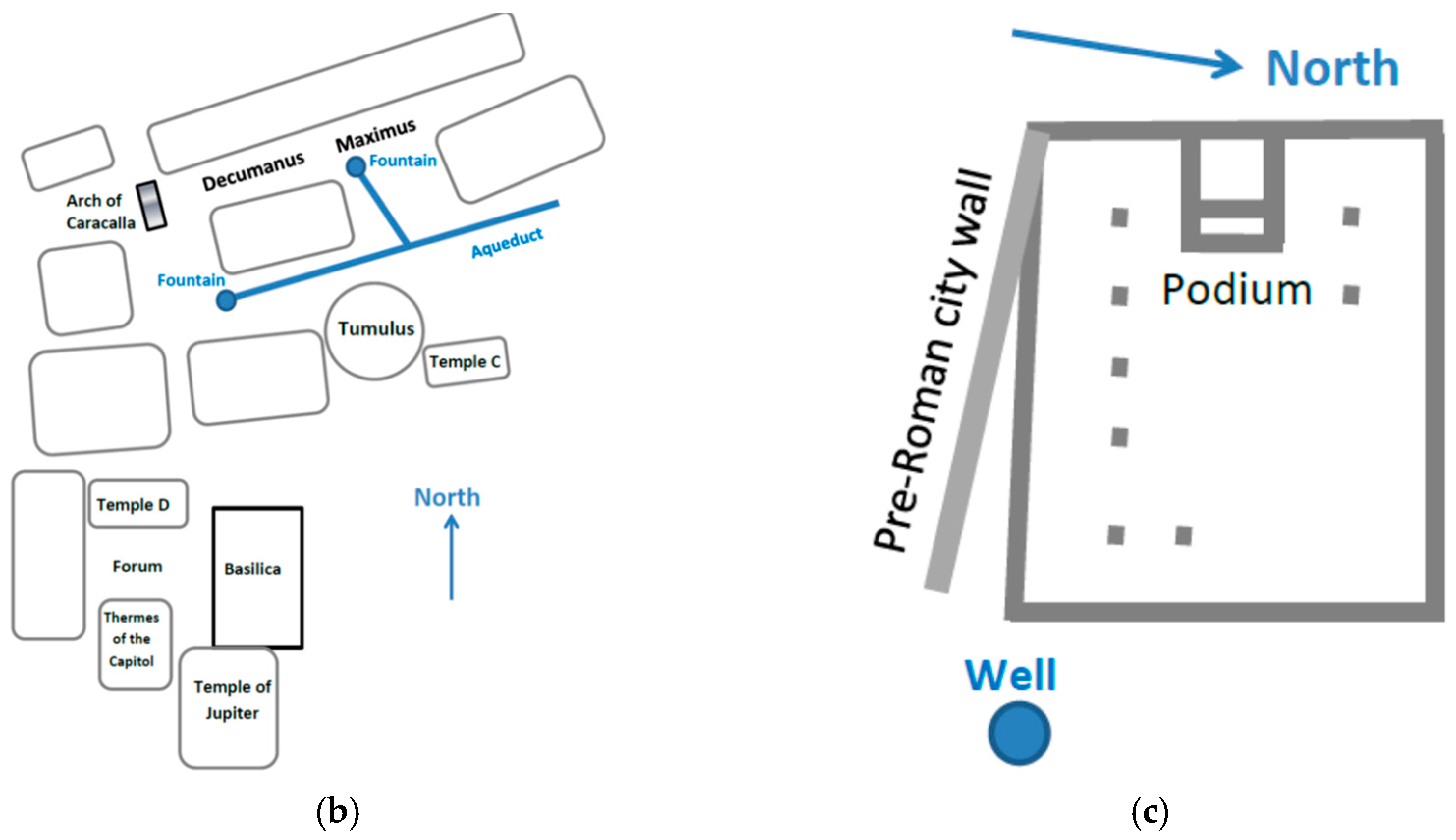
© 2019 by the authors. Licensee MDPI, Basel, Switzerland. This article is an open access article distributed under the terms and conditions of the Creative Commons Attribution (CC BY) license (http://creativecommons.org/licenses/by/4.0/).
Share and Cite
Andreeva, S.; Fedorchuk, A.; Nosonovsky, M. Revisiting Epigraphic Evidence of the Oldest Synagogue in Morocco in Volubilis. Arts 2019, 8, 127. https://doi.org/10.3390/arts8040127
Andreeva S, Fedorchuk A, Nosonovsky M. Revisiting Epigraphic Evidence of the Oldest Synagogue in Morocco in Volubilis. Arts. 2019; 8(4):127. https://doi.org/10.3390/arts8040127
Chicago/Turabian StyleAndreeva, Sofia, Artem Fedorchuk, and Michael Nosonovsky. 2019. "Revisiting Epigraphic Evidence of the Oldest Synagogue in Morocco in Volubilis" Arts 8, no. 4: 127. https://doi.org/10.3390/arts8040127
APA StyleAndreeva, S., Fedorchuk, A., & Nosonovsky, M. (2019). Revisiting Epigraphic Evidence of the Oldest Synagogue in Morocco in Volubilis. Arts, 8(4), 127. https://doi.org/10.3390/arts8040127





